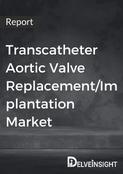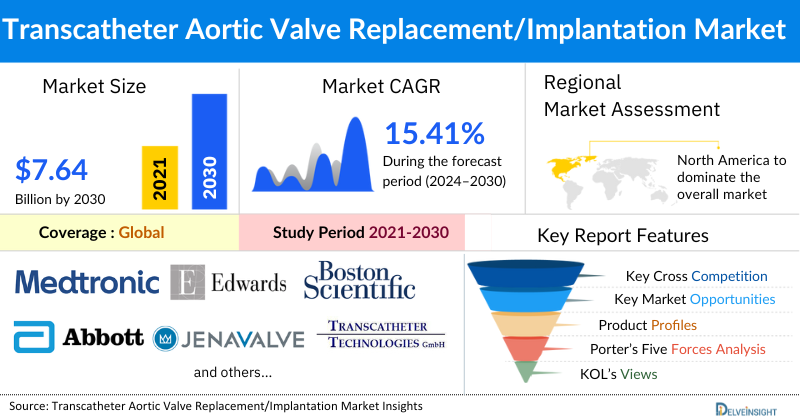transcatheter aortic valve replacement market
Transcatheter Aortic Valve Replacement Devices Market By Material [Valve Frame Material (Nitinol, Stainless Steel, Cobalt Chromium And Others), Valve Leaflet Material (Porcine, Bovine And Others)], By Procedure (Transfemoral, Transapical And Transaortic Approach), By Application (Aortic Stenosis, Aortic Regurgitation And Others), By End User (Hospitals, Ambulatory Surgical Centers, And Others), and by geography is expected to grow at a steady CAGR forecast till 2030 owing to an increasing prevalence of aortic stenosis disorder, increasing demand for TAVR procedures and technological advancements in the transcatheter aortic valve replacement arena.
Global Transcatheter Aortic Valve Devices Market was valued at USD 3.23 billion in 2023, growing at a CAGR of 15.41% during the forecast period from 2024 to 2030 to reach USD 7.64 billion by 2030. The demand for transcatheter aortic valve replacement devices is primarily being boosted by the increasing prevalence of aortic stenosis disorder, rise in cardiovascular disorders, increasing demand for TAVR procedures, increasing prevalence of aortic regurgitation and the technological advancements pertaining to the transcatheter aortic valve replacement arena which are expected to increase in the product demand thereby contributing in the growth of the transcatheter aortic valve replacement devices market during the forecast period from 2024-2030.
Transcatheter Aortic Valve Replacement Devices Market Dynamics:
The transcatheter aortic valve replacement devices market is witnessing an increase in product demand owing to numerous reasons and one of the key aspects being the rising prevalence of aortic stenosis disorder. According to the World Health Organization 2020, the prevalence of calcific aortic valve stenosis had been found to be 9 million across the world. Also, as per the John Muir Health statistics, in the year 2020, about 1.5 million people in the United States tend to suffer from aortic stenosis and about 500,000 people within this group of patients tend to suffer from severe aortic stenosis. As per the same source in 2020, about 250,000 patients suffering from aortic stenosis were symptomatic in the United States.
As per the European Society of Cardiology, 2020, Degenerative Calcific aortic stenosis is found to be very common (with a prevalence of 12.4%) in high-income countries. As per the same source, in the year 2020 the prevalence of severe aortic stenosis in people aged >=75 years is approximately 3.4% in Europe and the United States. Additionally, the disease is the second most common valvular lesion in the United States, affecting about 5% of the population at an age of 65 years in the year 2020. Due to the rise in aortic stenosis around the world, there will be a high demand for trans-catheter valves and TAVR procedures worldwide. As per the source, John Muir Health, up until 2021 45,000 patients have been implanted with Edwards’ trans-catheter valves alone by multi-disciplinary teams across the world. Therefore, due to the rise in aortic stenosis disorder and the rise in TAVR procedures worldwide, there will be an increase in the demand of transcatheter aortic valve replacement devices for implantation, thereby fueling the market growth for Transcatheter Aortic Valve Replacement Devices.
Another key aspect influencing the demand for transcatheter aortic valve replacement devices is the rising prevalence of cardiovascular disorders. As per the data provided by the World Health Organization 2021, cardiovascular disorders are considered as the leading cause of death worldwide affecting about 17.9 million lives every year. Furthermore, the World Heart Federation in the year 2019 had estimated that more than 23 million lives will be affected owing to cardiovascular disorders by the year 2030. Therefore, the rising prevalence of cardiovascular disorders across the globe is further expected to aid in the increasing demand for transcatheter aortic valve replacement devices, thereby boosting the growth of the global transcatheter aortic valve replacement devices market during the forecast period.
However, stringent regulatory approval process for transcatheter aortic valves and high costs associated with the TAVR procedures may prove to be challenging factors for the transcatheter aortic valve replacement devices market growth.
Transcatheter Aortic Valve Replacement Devices Market Segment Analysis:
Transcatheter Aortic Valve Replacement Devices Market By Material [Valve Frame Material (Nitinol, Stainless Steel, Cobalt Chromium and Others), Valve Leaflet Material (Porcine, Bovine and Others)], By Procedure (Transfemoral, Transapical and Transaortic Approach), By Application (Aortic Stenosis, Aortic Regurgitation and Others), By End User (Hospitals, Ambulatory Surgical Centers, and Others), and by Geography (North America, Europe, Asia-Pacific, and Rest of the World)
In the application segment of the transcatheter aortic valve replacement devices market, the TAVR devices used in the aortic stenosis segment is estimated to hold a significant share in the transcatheter aortic valve replacement devices market during the forecast period. This can be ascribed to the increasing prevalence of aortic stenosis disorder globally, approval and launch of TAVR devices indicated for use in aortic stenosis disorder and the technological advancements in the TAVR devices in the treatment of aortic stenosis. According to the American Heart Association, around 1.5 million people tend to suffer from aortic valve stenosis in the United States in the year 2020. As per the same source, around more than 100,000 patients had undergone TAVR procedures in the United States in contradiction to only 50,000 patients who had opted for open surgery for aortic valve replacement in the United States in the year 2020. Also in the year 2019, TAVR procedures were initially indicated for patients suffering from severe symptomatic aortic stenosis that were not suitable for surgery, as assessed by the Heart Valve Team, however the newer guidelines have approved the treatment of TAVR in intermediate risk patients of aortic stenosis. Therefore, due to the rise in patients suffering from aortic stenosis and the approval of TAVR procedures for intermediate risk patients of aortic stenosis, there will be an increase in demand for TAVR procedures by patients suffering from aortic stenosis, thereby leading to a growth in the TAVR devices market.
Additionally, the approval and launch of devices for aortic stenosis indication will lead to an increase in the demand of transcatheter aortic valve replacement devices in the aortic stenosis application, thereby leading to an increase in the overall transcatheter aortic valve replacement devices market growth. For instance, on September 21, 2021, the United States Food and Drug Administration had approved Abbott’s Portico with FlexNav transcatheter aortic valve replacement (TAVR) system for treatment of individuals suffering from symptomatic, and severe aortic stenosis.
North America is expected to dominate the Overall Transcatheter Aortic Valve Replacement Devices Market:
Among all the regions, North America is expected to account for the significant market revenue share in the transcatheter aortic valve replacement devices market. North America is expected to dominate the global market and would continue to maintain its dominance in revenue generation in the transcatheter aortic valve replacement devices market during the forecast period. This domination is attributed to the increasing number of aortic stenosis and aortic regurgitation cases, rising prevalence of cardiovascular diseases, rise in transcatheter aortic valve replacement device approvals and launches, and their expansion in newer indications are the key factor contributing to the transcatheter aortic valve replacement devices market in the country and are expected to aid in the growth of the North America transcatheter aortic valve replacement devices market.
According to the Centers for Disease Control and Prevention 2021, heart disease is the leading cause of death for men, women and people in United States. According to the same source, one person tends to die in every 36 seconds from cardiovascular diseases and about 6,59,000 people tends to die of heart diseases every year that is about one in four deaths. Furthermore, according to the American Heart Association 2021, in the year 2019 cardiovascular disorders was the leading cause of death in the United States and coronary heart disease had accounted to about 42.1% of the deaths attributable to CVD in the United States. Also, as per the former source, in the year 2018, stoke had accounted for about 1 in every 19 deaths in the United States. Owing to the rising cases of cardiovascular disorders, there will be an increase in demand of transcatheter aortic valve replacement devices, leading to a rise in the transcatheter aortic valve replacement devices market in the North American region.
Additionally, according to the American Heart Association, in the year 2020, 20% of the older Americans tend to suffer from aortic stenosis. It is common in people over the age of 65 years and if left untreated can cause heart failure and death. Owing to the increase in the prevalence of patients suffering from aortic stenosis, there will be an increase in the demand of TAVR devices, leading to an overall growth of the TAVR devices in the forecasting period of 2022-27.
Also, several approvals have also lead to increase in the demand for transcatheter aortic valve replacement devices, for instance FDA had approved Medtonic’s Evolut FX TAVR system in the year 2019 for all risk categories of patients with symptomatic and severe aortic stenosis in the United States. Additionally, on January 09, 2020, Jenavalve transcatheter aortic valve replacement system had been designated as a breakthrough device for severe aortic regurgitation (AR) and AR-dominant mixed aortic valve disease. Thus, owing to an increase in the number of approvals for TAVR devices in the United States, there will be an increase in availability and demand for TAVR devices in US leading to a growth in the overall market for TAVR devices.
Transcatheter Aortic Valve Replacement Devices Market Key Players:
Some of the key market players operating in the transcatheter aortic valve replacement devices market includes Medtronic, Edwards Lifesciences Corporation, Boston Scientific Corporation, Meril Life Sciences, Abbott, JenaValve Technology, Inc., Bracco SpA, Transcatheter Technologies GmbH, Braile Biomedica, Venus Medtech, Direct Flow Medical, Sorin group, Blue Sail Medical Co. Ltd., JC Medical Inc., Cook Medical Inc., Sysmetis SA, SMT Pvt Ltd., LivaNova, Peijia Medical, and P+F Products + Features GmbH.
Recent Developmental Activities in Transcatheter Aortic Valve Replacement Devices Market:
- In May 2025, Edwards Lifesciences announced that the U.S. Food and Drug Administration (FDA) has approved its SAPIEN 3 transcatheter aortic valve replacement (TAVR) therapy for use in severe aortic stenosis (AS) patients without symptoms. This approval marks the first time TAVR has been authorized for asymptomatic patients, expanding treatment options for individuals with severe AS.
- In April 2025, SoloPace Incorporated announced FDA clearance and the first use of its SoloPace control system for temporary pacing in transcatheter aortic valve implantation (TAVI) procedures. The system aims to enhance pacing efficiency and reduce patient risks, with initial cases completed at Scripps Clinic in San Diego.
- In March 2025, Medtronic plc (NYSE: MDT) announced late-breaking five-year data from the Evolut Low Risk Trial. The results show that, compared to surgery, the Evolut™ transcatheter aortic valve replacement (TAVR) system offers a numerically lower rate of all-cause mortality or disabling stroke at five years, along with strong valve performance and durable clinical outcomes.
- In Sept 2021, Abbott had announced that Food and Drug Administration (FDA) has approved the company's Portico™ with FlexNav™ transcatheter aortic valve replacement (TAVR) system to treat people with symptomatic, severe aortic stenosis who are at high or extreme risk for open-heart surgery.
- In Aug 2021, Medtronic plc, had announced the U.S. Food and Drug Administration (FDA) approval of its newest-generation, self-expanding transcatheter aortic valve replacement (TAVR) system, the Evolut™ FX TAVR system.
- In May 2021, Abbott had announced that it had received CE Mark for its latest-generation transcatheter aortic valve implantation (TAVI) system, Navitor™, making the minimally invasive device available for people in Europe with severe aortic stenosis who are at high or extreme surgical risk.
Key Takeaways from the Transcatheter Aortic Valve Replacement Devices Market Report Study
- Market size analysis for current transcatheter aortic valve replacement devices market size (2023), and market forecast for 5 years (2024-2030)
- The effect of the COVID-19 pandemic on this market is significant. To capture and analyze suitable indicators, our experts are closely watching the transcatheter aortic valve replacement devices market.
- Top key product/services/technology developments, merger, acquisition, partnership, joint venture happened for last 3 years
- Key companies dominating the Global Transcatheter Aortic Valve Devices Market.
- Various opportunities available for the other competitor in the Transcatheter Aortic Valve Devices Market space.
- What are the top performing segments in 2023? How these segments will perform in 2030.
- Which is the top-performing regions and countries in the current transcatheter aortic valve replacement devices market scenario?
- Which are the regions and countries where companies should have concentrated on opportunities for transcatheter aortic valve replacement devices market growth in the coming future?
Target Audience who can be benefited from this Transcatheter Aortic Valve Replacement Devices Market Report Study
- Transcatheter Aortic Valve Devices products providers
- Research organizations and consulting companies
- Transcatheter Aortic Valve Devices-related organizations, associations, forums, and other alliances
- Government and corporate offices
- Start-up companies, venture capitalists, and private equity firms
- Distributors and Traders dealing in transcatheter aortic valve replacement devices
- Various End-users who want to know more about the Transcatheter Aortic Valve Devices market and latest technological developments in the Transcatheter Aortic Valve Devices market.
Frequently Asked Questions for Transcatheter Aortic Valve Replacement Devices Market:
1. What are Transcatheter Aortic Valve Replacement Devices?
Transcatheter aortic valve replacement is a procedure wherein the diseased valve is replaced by an artificial, man-made valve. There are a number of man-made transcatheter aortic valves tahta are used while performing TAVR procedures. These include SAPIEN 3, SAPIEN 3 Ultra, Evolut PRO+, and LOTUS Edge.
2. What is the market for Global Transcatheter Aortic Valve Replacement Devices?
Global Transcatheter Aortic Valve Devices Market was valued at USD 3.23 billion in 2023, growing at a CAGR of 15.41% during the forecast period from 2024 to 2030 to reach USD 7.64 billion by 2030.
3. What are the drivers for Global Transcatheter Aortic Valve Replacement Devices Market?
The demand for transcatheter aortic valve replacement devices is primarily being boosted by the rising prevalence of aortic stenosis, rising prevalence of cardiovascular disorders, increase in aortic stenosis disorder, rising numbers of aortic regurgitation amongst the population, and increasing TAVR procedures which are expected to increase in the product demand thereby contributing in the growth of the transcatheter aortic valve replacement devices market during the forecast period from 2024-2030.
4. Who are the key players operating in Global Transcatheter Aortic Valve Replacement Devices Market?
Some of the key market players operating in the transcatheter aortic valve replacement devices market includes Medtronic, Edwards Lifesciences Corporation, Boston Scientific Corporation, Meril Life Sciences, Abbott, JenaValve Technology, Inc., Bracco SpA, Transcatheter Technologies GmbH, Braile Biomedica, Venus Medtech, Direct Flow Medical, Sorin group, Blue Sail Medical Co. Ltd., JC Medical Inc., Cook Medical Inc., Sysmetis SA, SMT Pvt Ltd., LivaNova, Peijia Medical, and P+F Products + Features GmbH.
5. Which region has the highest share in Transcatheter Aortic Valve Replacement Devices market?
North America is expected to dominate the overall Transcatheter Aortic Valve Devices market during the forecast period, 2024 to 2030. Owing to significant growth factors such as rising prevalence of aortic stenosis, increasing prevalence of cardiovascular disorders, favourable reimbursement policies and presence of key players, and new product approvals also propelled the market growth in this region.


